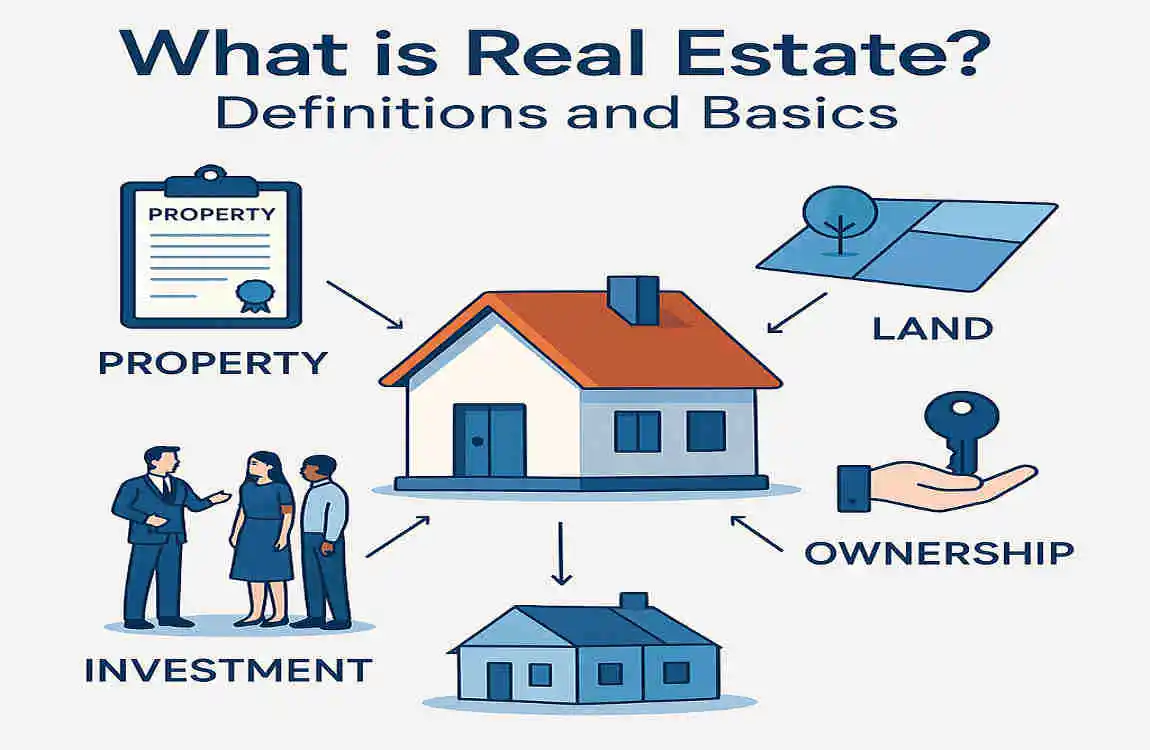Are you curious about the ins and outs of real estate homes? Do you want to understand how they work in today’s market? You’ve come to the right place! In this comprehensive guide, we’ll dive deep into the world of real estate homes, exploring their definition, how they function, and everything in between.
What is Real Estate? Definitions and Basics

Before we dive into real estate homes specifically, let’s first understand what real estate is in general. Real estate refers to land plus any permanent structures attached to it, such as houses, buildings, and infrastructure. It’s different from real property, which includes the land and any improvements made to it, as well as the rights associated with ownership. On the other hand, personal property refers to movable items that are not attached to the land, like furniture and appliances.
Real estate can be categorised into several types, including:
- Residential: Properties designed for people to live in, such as single-family homes, apartments, and townhouses.
- Commercial: Properties used for business purposes, like office buildings, retail stores, and warehouses.
- Industrial: Properties used for manufacturing, production, or storage, such as factories and distribution centres.
- Land: Undeveloped land that can be used for various purposes, including residential, commercial, or agricultural.
One reason real estate is considered a key asset class is the permanent improvements made to the land, such as houses and buildings. These improvements can significantly increase the property’s value and provide a stable source of income through rent or appreciation.
What is a Real Estate Home?
Now that we have a basic understanding of real estate, let’s focus on residential real estate. A real estate home is a residential property in the real estate market. It’s different from personal belongings because it’s attached to the land and cannot be easily moved.
When you own a real estate home, you have certain rights and responsibilities associated with the property. These include the right to use, enjoy, and dispose of the property as you see fit, as well as the obligation to maintain the property and pay property taxes.
The legal aspects of owning a home are crucial to understand. When you buy a home, you receive a title —a legal document that proves ownership of the property. You also receive a deed, which is a legal document that transfers ownership from the seller to the buyer. Understanding these legal aspects is essential for protecting your rights as a homeowner.
How Real Estate Homes Work in Today’s Market
Now that we know what a real estate home is, let’s explore how they work in today’s market. The modern real estate market is dynamic and constantly evolving, with various factors influencing the buying and selling process.
When you’re ready to buy or sell a home, the process typically begins with listing the property. This involves working with a real estate agent to create a listing that showcases the home’s features and price. The listing is then added to the Multiple Listing Service (MLS), a database that allows other agents to view the property and show it to potential buyers.
Once a buyer expresses interest in the home, the negotiation process begins. This involves back-and-forth discussions between the buyer and seller, often with the help of their respective agents, to reach an agreement on the sale price and terms.
If an agreement is reached, the sales process moves forward. This includes conducting inspections and appraisals to ensure the property’s condition and value align with the agreed-upon price. Once these steps are complete, the closing process begins, which involves signing legal paperwork and transferring ownership from the seller to the buyer.
Throughout this process, real estate agents and brokers play a crucial role. They act as intermediaries between buyers and sellers, facilitating transactions and ensuring a smooth experience for all parties involved.
How Homes Gain and Retain Value
One of the key aspects of real estate homes is their ability to gain and retain value over time. Several factors contribute to this, including:
- Improvements: Renovations and upgrades made to the home can increase its value and appeal to potential buyers.
- Location: Homes in desirable neighbourhoods or areas with good schools, amenities, and job opportunities tend to hold their value better than those in less desirable locations.
- Market trends: The overall health of the real estate market can impact a home’s value. In a seller’s market, where demand is high and inventory is low, home values tend to rise. In a buyer’s market, where inventory is high and demand is low, home values may decrease.
Financing Options for Buying a Home
When buying a home, financing is crucial. Most people don’t have the cash on hand to purchase a home outright, so they turn to mortgages and loans to help finance the purchase.
A mortgage is a loan specifically designed for buying a home. It’s secured by the property itself, meaning that if the borrower fails to make payments, the lender can foreclose on the property to recover its losses. There are various types of mortgages available, including fixed-rate and adjustable-rate mortgages, each with its own set of terms and conditions.
In addition to mortgages, other financing options include home equity loans and lines of credit. These allow homeowners to borrow against the value of their home to fund home improvements, debt consolidation, or other expenses.
The Impact of Economic Factors on Real Estate Homes
The real estate market is closely tied to the overall economy. Several economic factors can impact the buying and selling of real estate homes, including:
- Interest rates: When interest rates are low, borrowing costs are lower, making it more affordable to buy a home. When interest rates rise, borrowing costs increase, which can slow down the real estate market.
- Supply and demand: The balance between the number of homes available for sale and the number of buyers in the market can impact home prices and the overall health of the real estate market.
- Economic growth: A strong economy with low unemployment and rising wages can boost consumer confidence and increase demand for real estate homes. Conversely, a weak economy with high unemployment and stagnant wages can decrease demand and put downward pressure on home prices.
Key Components of a Real Estate Home Transaction
Now that we’ve covered the basics of how real estate homes work, let’s dive deeper into the key components of a real estate home transaction.
Listing and Marketing the Home
When you’re ready to sell your home, the first step is to list it. This involves working with a real estate agent to create a listing that showcases the home’s features, price, and any other relevant information. The listing is then added to the Multiple Listing Service (MLS), which allows other agents to view the property and show it to potential buyers.
In addition to the MLS, your agent may also market the home through various online platforms, such as real estate websites and social media. These platforms allow your home to reach a wider audience and increase its visibility to potential buyers.
The Role of Buyer’s and Seller’s Agents
In a real estate home transaction, both the buyer and seller typically work with their own real estate agents. The buyer’s agent represents the buyer’s interests, helping them find suitable properties, negotiate offers, and navigate the buying process. The seller’s agent, on the other hand, represents the seller’s interests, helping them price and market the home, negotiate offers, and navigate the selling process.
Both agents play a crucial role in facilitating the transaction and ensuring a smooth experience for their respective clients. They act as intermediaries, communicating between the buyer and seller, and helping to resolve any issues that may arise during the process.
Negotiating Sale Terms and Price
Once a potential buyer expresses interest in the home, the negotiation process begins. This involves back-and-forth discussions between the buyer and seller, often with the help of their respective agents, to reach an agreement on the sale price and terms.
During negotiations, the buyer may submit an offer to purchase the home, which includes the proposed price and any contingencies or conditions. The seller can then accept, reject, or counter the offer. This process continues until both parties reach a mutually acceptable agreement.
The Closing Process
Once an agreement is reached, the closing process begins. This involves several key steps, including:
- Inspections: The buyer may conduct a home inspection to assess the property’s condition and identify potential issues or needed repairs.
- Appraisals: The lender may require an appraisal to determine the home’s value and ensure it aligns with the agreed-upon price.
- Legal paperwork: The buyer and seller must sign various legal documents, including the purchase agreement, deed, and any other required forms.
- Transfer of ownership: Once all the paperwork is complete, the property’s ownership is transferred from the seller to the buyer.
Post-Sale Ownership Responsibilities
After the sale is complete, the new homeowner takes on various ownership responsibilities. These include:
- Maintenance: The homeowner is responsible for maintaining the property, including making repairs and keeping it in good condition.
- Property taxes: The homeowner must pay property taxes on the home, which are typically assessed annually by the local government.
- Insurance: The homeowner may choose to purchase homeowners’ insurance to protect the property against damage or loss.
- HOA fees: If the home is part of a homeowners association (HOA), the owner may be required to pay monthly or annual fees to cover shared expenses and amenities.
Benefits and Risks of Investing in Real Estate Homes
Investing in real estate homes can offer several benefits, including:
- Asset appreciation: Over time, real estate homes can appreciate in value, allowing the owner to build equity and potentially sell the house for a profit.
- Rental income: If the owner chooses to rent out the home, they can generate a steady stream of rental income to help cover expenses and build wealth.
- Tax advantages: Homeowners may be eligible for various tax deductions and credits, such as mortgage interest and property tax deductions.
However, investing in real estate homes also comes with certain risks, including:
- Market fluctuations: The real estate market can be volatile, with home values and rental rates subject to change based on economic conditions and other factors.
- Maintenance costs: Owning a home entails ongoing repairs and maintenance, which can eat into an owner’s profits and cash flow.
- Liquidity issues: Real estate is not a liquid asset, meaning it can take time to sell a home and access the funds tied up in the property.
To mitigate these risks, investors need to conduct thorough research and seek professional advice before making any investment decisions. This can help them make informed choices and minimise potential losses.
How to Get Started with Real Estate Homes: Tips for Buyers and Sellers

Whether you’re a first-time homebuyer or a seasoned seller, getting started with real estate homes can be an exciting but daunting process. Here are some tips to help you navigate the market:
Steps for First-Time Homebuyers
If you’re a first-time homebuyer, here are some steps to help you get started:
- Assess your finances: Review your income, expenses, and credit score to determine how much home you can afford.
- Get pre-approved for a mortgage: Work with a lender to get pre-approved for a mortgage, which will give you a better idea of your buying power and help you make a competitive offer.
- Work with a real estate agent: Find a knowledgeable and experienced real estate agent who can help you navigate the market and find the right home for your needs and budget.
- Start searching for homes: Use online platforms and work with your agent to find homes that meet your criteria, and schedule in-person showings.
- Make an offer: When you find a home you love, work with your agent to submit a competitive offer and negotiate the terms of the sale.
How Sellers Can Prepare Their Homes for the Market
If you’re a seller, here are some tips to help you prepare your home for the market:
- Declutter and depersonalise: Remove personal items and excess clutter to make the home feel more spacious and inviting to potential buyers.
- Make necessary repairs: Fix minor issues and address any other needed repairs to ensure the home is in good condition and ready for showings.
- Stage the home: Highlight its best features to help buyers envision themselves living there.
- Price the home competitively: Work with your agent to set a price based on recent sales data and market conditions.
- Market the home effectively: Use a combination of online and offline marketing strategies to reach a broad audience of potential buyers.
The Importance of Market Research and Professional Guidance
Whether you’re a buyer or a seller, conducting market research and seeking professional guidance is crucial for making informed decisions and achieving your real estate goals.
Take the time to research the local market, including recent sales data, home values, and market trends. This will help you understand the current market state and make more accurate predictions about future trends.
In addition, working with a knowledgeable and experienced real estate agent can provide valuable guidance and support throughout the buying or selling process. They can help you navigate the market, negotiate offers, and ensure a smooth and successful transaction.
Tips on Financing and Negotiating Smartly
When it comes to financing and negotiating a real estate home transaction, here are some tips to help you navigate the process:
- Shop around for the best mortgage rates: Don’t settle for the first mortgage offer you receive. Shop around and compare rates from multiple lenders to ensure you’re getting the best deal.
- Consider different financing options: In addition to traditional mortgages, explore FHA or VA loans to find the best fit for your needs and budget.
- Be prepared to negotiate: Real estate transactions often involve negotiation, so be ready to make and counter offers until you reach a mutually acceptable agreement.
- Don’t be afraid to walk away: If the deal isn’t right for you, don’t be scared to walk away and continue searching for a better opportunity.
Current Trends in Real Estate Homes
The real estate market is constantly evolving, with new trends and technologies shaping the way homes are bought and sold. Here are some of the current trends in real estate homes:
Hot Trends in Residential Real Estate
Some of the hottest trends in residential real estate include:
- Smart homes: Homes equipped with innovative technology, such as smart thermostats, lighting, and Security systems, are becoming increasingly popular among buyers.
- Eco-friendly homes: Homes designed with sustainability in mind, such as those with solar panels, energy-efficient appliances, and green building materials, are also in high demand.
- Location preferences: Buyers are increasingly prioritising walkable neighbourhoods, access to amenities, and proximity to good schools and job opportunities.
How Technology is Changing Home Buying and Selling
Technology is revolutionising the way homes are bought and sold, with several key trends emerging:
- Online platforms: Real estate websites and apps are making it easier than ever for buyers to search for homes and connect with agents online.
- Virtual tours and 3D walkthroughs let buyers view homes remotely, saving time and increasing convenience.
- Digital transactions: More and more real estate transactions are being conducted digitally, with electronic signatures and online document management streamlining the process.
Changing Buyer Preferences Post-Pandemic
The COVID-19 pandemic has had a significant impact on the real estate market, with buyer preferences shifting in several ways:
- More space: With more people working and learning from home, buyers are prioritising larger homes with dedicated office spaces and outdoor areas.
- Suburban migration: Many buyers are moving from urban areas to suburban or rural locations in search of more space and a better quality of life.
- Health and safety: Buyers are placing greater emphasis on features such as air purification systems and touchless technology.
